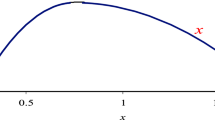Abstract
In this paper, the single-variable fuzzy polynomial equations are studied. We firstly define two solution types for the equations, called solution and r-cut solution. Then, sufficient and necessary conditions are proposed for existence of the solution and r-cut solution of the equations, respectively. Also, a new algorithm is designed to find all the solutions and r-cut solutions of the equations using algebraic computations. Based on Descartes’ rule of signs, we express and prove a fuzzy version of fundamental theorem of algebra to obtain the number of real roots of a single-variable fuzzy polynomial. Moreover, we present an upper bound on the number of solutions of the equations and show that each single-variable fuzzy polynomial equation has at most two distinct solutions.
Similar content being viewed by others
Explore related subjects
Discover the latest articles, news and stories from top researchers in related subjects.References
Abbaoui K, Cherruault Y (1994) Convergence of Adomain’s method applied to nonlinear equations. Math Comput Model 20(9):69–73
Abbasbandy S (2003) Improving Newton–Raphson method for nonlinear equations by modified Adomain decomposition method. Appl Math Comput 145:887–893
Abbasbandy S (2005) Extended Newton method for a system of nonlinear equations by modified Adomain decomposition method. Appl Math Comput 170:648–656
Abbasbandy S, Amirfakhrnian M (2006) Numerical approximation of fuzzy function by fuzzy polynomials. Appl Math Comput 174:669–675
Abbasbandy S, Asady B (2004) Newton’s method for solving fuzzy nonlinear equations. Appl Math Comput 159:349–356
Abbasbandy S, Ezzati R (2006) Newton’s method for solving fuzzy nonlinear equations. Appl Math Comput 175:1189–1199
Abbasbandy S, Jafarian A (2006) Steepest descent method for solving fuzzy nonlinear equations. Appl Math Comput 174(1):669–675
Abbasbandy S, Otadi M (2006) Numerical solution of fuzzy polynomials by fuzzy neural network. Appl Math Comput 181:1084–1089
Abbasbandy S, Otadi M, Mosleh M (2008) Numerical solution of a system of fuzzy polynomials by fuzzy neural network. Inf Sci 178:1948–1960
Adomain G, Rach R (1985) On the solution of algebraic equations by the decomposition method. J Math Anal Appl 105(1):141–166
Ahmadzade H, Amini M, Taheri SM, Bozorgnia A (2014) Some moment inequalities for fuzzy martingales and their applications. J Uncertain Anal Appl 2:1–14
Allahviranloo M, Asari S (2011) Numerical solution of fuzzy polynomials by Newton–Raphson method. J Appl Math Sci 7(4):17–24
Allahviranloo M, Otadi M, Mosleh M (2007) Iterative method for fuzzy equations. Soft Comput 12:935–939
Amirfakhrian M (2008) Numerical solution of algebraic fuzzy equations with crisp variable by Gauss–Newton method. Appl Math Model 32:1859–1868
Amirfakhrian M (2012) Analyzing the solution of a system of fuzzy linear equations by a fuzzy distance. Soft Comput 16(6):1035–1041
Buckley JJ (1991) Solving fuzzy equations: a new solution concept. Fuzzy Sets Syst 39(3):291–301
Buckley JJ, Eslami E (1997) Neural net solution of fuzzy problems: the quadratic equation. Fuzzy Sets Syst 86:289–298
Buckley JJ, Qu Y (1990a) Solving linear and quadratic fuzzy equations. Fuzzy Sets Syst 38(1):43–59
Buckley JJ, Qu Y (1990b) On using \(\alpha \)-cuts to evaluate fuzzy equations. Fuzzy Sets Syst 38(3):309–312
Buckley JJ, QU Y (1992) Solving fuzzy equations in economics and finance. Fuzzy Sets Syst 48(3):289–296
Buckley JJ, Eslami E, Hayashi Y (1997) Solving fuzzy equations using neural nets. Fuzzy Sets Syst 86(3):271–278
Buckley JJ, Feuring T, Hayashi Y (2002) Solving fuzzy equations using evolutionary algorithms and neural nets. Soft Comput A Fus Found Methodol Appl 6:116–123
Cox D, Little J, O’Shea D (2007) Ideal, varieties, and algorithms: an introduction to computational algebra geometry and commutative algebra, 3rd edn. Springer, New York
Ezzati R (2011) Solving fuzzy linear systems. Soft comput 15(1):193–197
Farahani H, Rahmany S, Basiri A, Molai AA (2015) Resolution of a system of fuzzy polynomial equations using eigenvalue method. Soft Comput 19(2):283–291
Farahani H, Nehi HM, Paripour M (2016) Solving fuzzy complex system of linear equations using eigenvalue method. J Intell Fuzzy Syst 31(3):1689–1699
Kajani MT, Asady B, Vencheh AH (2005) An iterative method for solving dual fuzzy nonlinear equations. Appl Math Comput 167:316–323
Klir GJ, Yuan B (1995) Fuzzy sets and fuzzy logic, theory and applications. Prentice Hall, Upper Saddle River
Malkawi G, Ahmad N, Ibrahim H (2014) On the weakness of linear programming to interpret the nature of solution of fully fuzzy linear system. J Uncertain Anal Appl 2:1–23
Mignotte M (1992) Mathematics for computer algebra. Springer, New York
Mosleh M, Otadi M (2010) A new approach to the numerical solution of dual fully fuzzy polynomial equations. Int J Ind Math 2(2):129–142
Noor’ani A, Kavikumar J, Mustafa M, Nor S (2011) Solving dual fuzzy polynomial equation by ranking method. Far East J Math Sci 51(2):151–163
Otadi M, Mosleh M (2011) Solution of fuzzy polynomial equations by modified Adomain decomposition method. Soft Compu 15:187–192
Salehnegad M, Abbasbandy S, Mosleh M, Otadi M (2010) Canonical representation for approximating solution of fuzzy polynomial equations. Iran J Optim 3:447–454
Salkuyeh DK (2011) on the solution of the fuzzy Sylvester matrix equation. Soft Comput 15(5):953–961
Zadeh L (1965) Fuzzy sets. Inf Control 8:338–353
Zadeh L (1975a) The concept of a linguistic variable and its application to approximate reasoning: part 3. Inf Sci 9:43–80
Zadeh L (1975b) The concept of a linguistic variable and its application to approximate reasoning: parts 1–2. Inf Sci 8(199–249):301–357
Zadeh L (2005) Toward a generalized theory of uncertainty (gtu) an outline. Inf Sci 172:1–40
Author information
Authors and Affiliations
Corresponding author
Ethics declarations
Conflict of interest
The authors declare that they have no conflict of interest
Additional information
Communicated by V. Loia.
Rights and permissions
About this article
Cite this article
Farahani, H., Paripour, M. & Abbasbandy, S. Resolution of single-variable fuzzy polynomial equations and an upper bound on the number of solutions. Soft Comput 23, 837–845 (2019). https://doi.org/10.1007/s00500-017-2790-5
Published:
Issue Date:
DOI: https://doi.org/10.1007/s00500-017-2790-5




